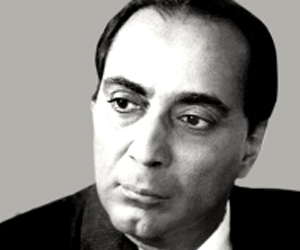Homi Jehangir Bhabha (30 October 1909 – 24 January 1966) was an Indian nuclear physicist, founding director, and professor of physics at the Tata Institute of Fundamental Research.Colloquially known as “father of the Indian nuclear programme”,Bhabha was the founding director of two well-known research institutions, namely the Tata Institute of Fundamental Research (TIFR) and the Trombay Atomic Energy Establishment (now named after him); both sites were the cornerstone of Indian development of nuclear weapons which Bhabha also supervised as its director.
Homi Jehangir Bhabha was born into a wealthy and prominent industrial Parsi family, through which he was related to Dinshaw Maneckji Petit, and Dorabji Tata. He was born on 30 October 1909, in an illustrious family with a long tradition of learning and service to the country. His father was Jehangir Hormusji Bhabha, a well known lawyer and his mother was Meheren.He received his early education at Bombay’s Cathedral and John Connon School and entered Elphinstone College at age 15 after passing his Senior Cambridge Examination with Honors. His father’s name, Jehangir, is from Persian, meaning “conqueror of the world.”
He then attended the Royal Institute of Science until 1927 before joining Caius College of Cambridge University. This was due to the insistence of his father and his uncle Dorab Tata, who planned for Bhabha to obtain a degree in Mechanical engineering from Cambridge and then return to India, where he would join the Tata Steel Mills in Jamshedpur as a metallurgist.
Research in Nuclear physics
In January 1933, Bhabha received his doctorate in nuclear physics after publishing his first scientific paper, “The Absorption of Cosmic radiation”. In the publication, Bhabha offered an explanation of the absorption features and electron shower production in cosmic rays. The paper helped him win the Isaac Newton Studentship in 1934, which he held for the next three years. The following year, he completed his doctoral studies in theoretical physics under Ralph H. Fowler. During his studentship, he split his time working at Cambridge and with Niels Bohr in Copenhagen. In 1935, Bhabha published a paper in the Proceedings of the Royal Society, Series A, in which performed the first calculation to determine the cross section of electron-positron scattering. Electron-positron scattering was later named Bhabha scattering, in honor of his contributions in the field.
In 1936, the two published a paper, “The Passage of Fast Electrons and the Theory of Cosmic Showers”in the Proceedings of the Royal Society, Series A, in which they used their theory to describe how primary cosmic rays from outer space interact with the upper atmosphere to produce particles observed at the ground level. Bhabha and Heitler then made numerical estimates of the number of electrons in the cascade process at different altitudes for different electron initiation energies. The calculations agreed with the experimental observations of cosmic ray showers made by Bruno Rossi and Pierre Victor Auger a few years before. Bhabha later concluded that observations of the properties of such particles would lead to the straightforward experimental verification of Albert Einstein’s theory of relativity. In 1937, Bhabha was awarded the Senior Studentship of the 1851 exhibition, which helped him continue his work at Cambridge until the outbreak of World War II in 1939.
Legacy
Bust of Homi Bhabha which is placed in the garden of Birla Industrial & Technological Museum, Kolkata
After his death, the Atomic Energy Establishment at Bombay was renamed as the Bhabha Atomic Research Centre in his honour.
In addition to being an able scientist and administrator, Bhabha was also a painter and a classical music and opera enthusiast, besides being an amateur botanist.He is one of the most prominent scientists that India has ever had. Bhabha also encouraged research in electronics, space science, radio astronomy and microbiology.The famed radio telescope at Ooty, India was his initiative, and it became a reality in 1970. The Homi Bhabha Fellowship Council has been giving the Homi Bhabha Fellowships since 1967 Other noted institutions in his name are the Homi Bhabha National Institute, an Indian deemed university and the Homi Bhabha Centre for Science Education, Mumbai, India.
(Ref:https://en.wikipedia.org/wiki/Homi_J._Bhabha &
